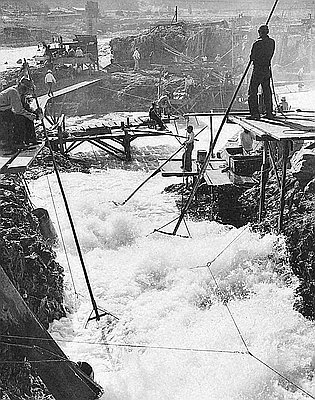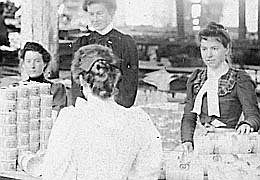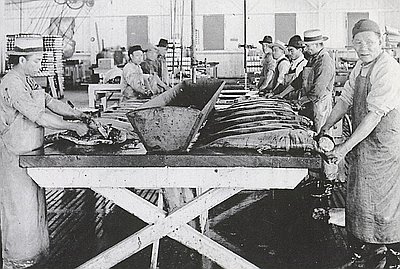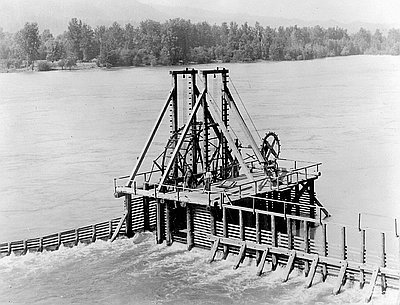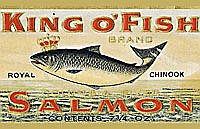Ecological Consequences
The environmental impact of salmon canneries was significant. The industrial harvest expanded rapidly during its first three decades, and canneries produced tremendous waste during boom times. Heads, tails, fins, and offal were not processed, so workers washed those body parts off the dock. The refuse sank to the bottom of the river and decayed.
Working and living in such conditions was onerous, yet the garbage had an ecological benefit. The smell attracted not only flies but also bottom-dwelling carrion eaters such as Dungeness crab. For the Asians and Indians who lived in bunkhouses next to canneries, the river bottom around canneries was a productive crabbing grounds that helped diversify their diets. For nearby residents, however, cannery odors were a nuisance, and settlement patterns in Astoria and other cannery towns tended to reflect the ability of people to escape the bad smells.
Cannery wastes also illustrate the importance of nature in the history of salmon fishery management. When huge runs plugged canneries, as they did between July 24 and August 10, 1896, the salmon were so plentiful, according to one canner, “that the canneries, run to there [sic] greatest capacity, could not put up near all the fish, probably about one-half.” Processing could take so long that huge piles of salmon rotted on docks, and workers had to shovel the mess into the river. Such episodes led the Morning Oregonian to decry the “horrible waste of the raw material.”
By 1894, the head of the United States Fish Commission had concluded “that the number of salmon now reaching the head waters of streams in the Columbia River basin is insignificant in comparison” to former years. Marshall McDonald blamed the decline on “the great commercial fisheries prosecuted in the lower river” and prophesied “inevitable disaster.” To a certain extent, he was correct. The fisheries had become an enormous, unrestrained, consuming engine by the 1890s, yet many other factors also contributed to the unfolding disaster. Mining and grazing had silted spawning beds, log drives had scoured streams, mills had polluted waters, and logging, irrigation, and power dams had blocked waterways. This instability was exacerbated by droughts, floods, and shifts in ocean climate. A complex set of human and natural factors were killing salmon, but most observers found it difficult not to fixate on the piles of rotting fish. Canneries were the most conspicuous symbols of environmental ruin.
Everyone was certain that greed was to blame for the environmental decline, yet sometimes nature was responsible for downturns in the fisheries. In 1877, for example, the spring run proved alarmingly small, and for the first time canneries had to fish the fall runs to complete their pack. The Daily Astorian feared that “this will be the last season for profitable salmon fishing interests on the Columbia.” Many canners agreed and moved to other coastal streams, to British Columbia, and to Alaska. In 1877, however, a dry and balmy winter, ocean temperatures that were warm enough to lure porpoises into the mouth of the Columbia, and tree-ring evidence from Peru suggests that the culprit was not fishing but El Niño. Nature hiccupped, but people blamed overfishing. Over time, human activities did play the principal role in destroying salmon runs and habitat, but the events of 1877 set in motion a series of reactions that thoroughly altered the course of the industrial fishery and salmon management.
Although canners and fishers opposed restrictions on their activities, the same was true for every other industry in the Pacific Northwest. Loggers, farmers, miners, dam-builders, and city boosters were no more willing to rein in their operations to protect the environment. Their resistance to regulation, however, did not mean that they did not care about salmon. In fact, in 1876 cannery owners sent one of the earliest petitions requesting that the federal government build a salmon hatchery on the Columbia River. When salmon runs plummeted in 1877, it was canners such as John Adair Jr., J.G. Megler, James Cook, Capt. John West, and Charles Lewis who formed a private board to subsidize the first federal hatchery on the Clackamas River. Cannery owners remained among the most adamant supporters of hatchery programs throughout the nineteenth and early twentieth centuries. They were also the first organized group to oppose transplanting salmon and damming the Columbia River. Their technological solutions never quite worked, and hatcheries could not make enough salmon to preclude economic restraints.
Hope faded as harvests of chinook and sockeye declined after 1890. Fishers and canners first responded by beginning to can Coho, steelhead, chum, and pink salmon. Consumers showed less interest in these species, however, so canneries graded their product based on the relative color, texture, and fat content of the species. Only the Columbia’s top-graded “royal Chinook” and sockeye were considered gourmet items. Lesser species were sold at bargain basement prices to blue-collar consumers or the military, which purchased huge amounts of canned salmon during World War I and World War II.
Underlying these trends was the variable and fragile nature of salmon. Pacific salmon were not uniformly desirable, and the coveted species were becoming rare. Fewer fish and falling prices ate at profit margins. Columbia River canneries entered an era of diminishing opportunity, and “fish fights” broke out as various factions blamed each other for destroying the resource. Lower Columbia interests accused upriver canneries of creating an “almost insurmountable barrier to the salmon,” while upriver canners claimed that downriver competitors were trying to “Hog-It-All.” On the Columbia, conservation came to mean not just saving salmon—something all dearly wanted—but retaining their portion of a shrinking pie. In dire instances, fishers resorted to violence and even murder to maintain access to the fishery.
© Joseph E. Taylor III, 2006. Updated and revised by OHP staff, 2014.

